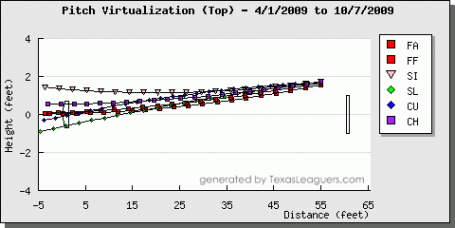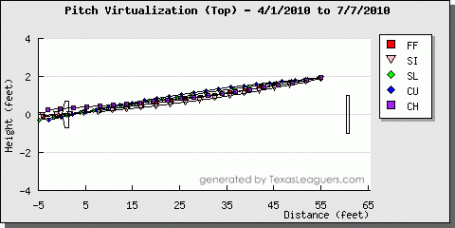In the midst of speculations involving Seattle’s Cliff Lee, one major league source has cited the Mariners’ interest in Kevin Slowey as a key piece of a potential deal. As the Mariners compile their due diligence, hoping to leverage the trade deadline’s best trading chip for the highest possible return, those that are in the “Acquire Cliff Lee Now” camp should hope that Seattle’s scouts were not paying attention to the Twins starter the past several weeks: In his last five starts, Slowey has been tagged for 35 hits in 24.2 innings of work leading to 24 runs scored.
While Lee would improve a rotation that is down on its luck at the moment, the long-term sustainability of the organization has to be considered when measuring any trade. Slowey is still young, affordable and has compiled an impressive minor league track record that would suggest this is a hiccup. Then again, with the recent surgically repaired wrist less than a year ago, Slowey may be experiencing difficulties adjusting to what he described in the spring as a new sensation and wondered aloud if he would “ever feel the same like I did before.”
The obvious reality is that his stuff just isn’t quite there in 2010. While he is still master of the strike zone’s domain - throwing strikes regularly and working ahead of hitters - the opposition is raking line drives and deep fly balls all over league. As a point of order, Slowey has always been near the bottom of the league in inducing worm-burners, but this season his groundball rate has sunk to a new low of 27% - the lowest in baseball by a wide margin.
The added elevation off of opponents' bats correlates with the loss of movement in his breaking pitches. Although his fastball remains a very effective pitch in his repertoire, his secondary pitches, the curveball and slider, has not had the same results from prior seasons:
Slowey’s Curve/Sliders
|
Pct Thrown
|
Chase%
|
Miss%
|
Groundball%
|
2010
|
14%
|
16%
|
11%
|
28%
|
2009
|
21%
|
30%
|
19%
|
41%
|
2008
|
23%
|
36%
|
25%
|
40%
|
Essentially, hitters have strayed after fewer out-of-zone pitches and missed less frequently. In short, he’s not fooling anybody with the breaking action.
Reviewing his pitch f/x virtualization charts - which are the average path that a pitcher’s pitches take from the release point to the catcher’s mitt, as shown from a bird’s-eye view – reveals that his arsenal is not producing the same movement as it had in the past. Give additional attention to the green diamond, his slider:

Slowey - 2008

Slowey - 2009

Slowey - 2010
As you can derive from those graphs, on average, Slowey’s non-fastball offerings are flat and catching far too much of the strike zone. As a result, hitters have been able to cause damage by posting a 1.095 OPS on his curve/slider (versus a .609 league-average OPS on those types of pitches). Losing confidence in a pitch (or pitches) for a control-orient pitcher can have nasty consequences. As Jesse Lund at TwinkieTown.com pointed out, Slowey basically eliminated throwing any semblance of a breaking pitch in his most recent start in Toronto, throwing 87 fastballs out of 98 pitches. This pitch selection led to two home runs and nine hits in 6.1 innings in Canada.
The real question then is if this is a temporary setback or if it is indeed the reprecussions of his wrist surgery that may have long-lasting effects. Basically, would trading Slowey now be a "sell-low" maneuver for the Twins, allowing the Mariners benefit from his continuing production when he fully recovers, or would it be an unloading of a commodity that is slightly damaged and may never live up to expectation? The answer to that is the difference between a bad trade and a good one.

No comments:
Post a Comment